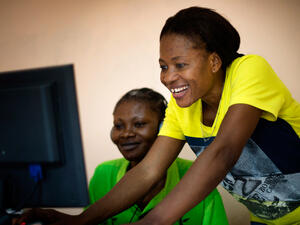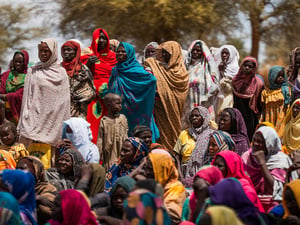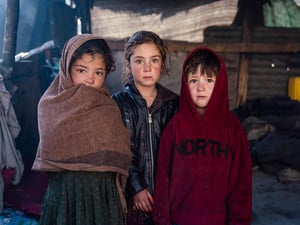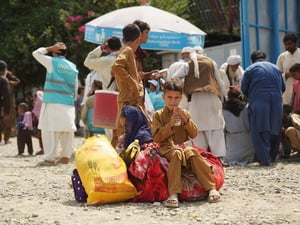Afghan "recyclers" under scrutiny of new technology
Afghan "recyclers" under scrutiny of new technology

Iris checks in Takhtabaig Voluntary Repatriation Centre help to prevent Afghan refugees from claiming return assistance more than once.
PESHAWAR, Pakistan, October 3 (UNHCR) - Afghan refugees eyeing a second helping of UNHCR's repatriation assistance have hit a blind spot with the arrival of state-of-the-art iris-recognition technology in Pakistan.
The UN refugee agency this week started testing an iris-recognition system among Afghan refugees in Peshawar as an additional measure to prevent the "recycling" of individuals seeking the multiple disbursement of its return assistance package. Starting Monday, all Afghans aged above 16 registering to go home at Takhtabaig Voluntary Repatriation Centre (VRC) have to go through an iris check before proceeding to other verification and registration steps as part of a month-long test of the new technology.
Based on the fact that each human iris is unique, a photographic image of the iris is captured ("enrolled") with a standard camera using near-invisible infrared light, converted into digital format and stored. It takes only about one second to match an enrolled iris against the database, thereby checking whether the same person has been recorded before.
On Monday, UNHCR scanned more than 1,500 potential returnees at Takhtabaig. Two refugees who had sought assistance twice on the same day were detected by the iris technology. When further checks revealed that they had already received assistance earlier this year, they were told to leave the VRC.
Of the more than 500 Afghans scanned on Tuesday, 13 were rejected by the iris check. One woman who was turned away admitted she had been through the process eight times. Her husband had forced her and their five children to come back again and again to try and get another cash grant. She expressed her gratitude for the new technology, hoping it would make her husband give up the exhausting exercise.
"The overwhelming majority of those who have received travel assistance were refugees intent on returning to Afghanistan," said Hasim Utkan, head of UNHCR in Pakistan. "But there were some who tried to take advantage of the system, seeking funds more than once that are needed to help those genuinely going back to their homeland."
He added, "If this test proves successful, we will be able to add iris technology to our existing checks and ensure that only Afghan refugees moving back to their country receive travel assistance."
Under the joint UNHCR-Afghan government voluntary repatriation programme, every individual returning to Afghanistan receives transport assistance ranging from $5 to $30 - depending on his final destination - a UNHCR family kit with plastic tarpaulin, soap and hygiene items, as well as wheat flour from the World Food Programme (WFP).
The iris-recognition technology being tested in Peshawar will enhance UNHCR's ability to identify genuine returnees entitled to the one-time return assistance package. This new method complements existing verification efforts like interviewing potential returnees and examining their family photos.
Since March, the UN refugee agency has helped more than 1.5 million Afghans return home from Pakistan. It has also turned away more than 396,000 "recyclers", or false claimants. Verification efforts have already saved UNHCR more than $8 million in travel assistance, plus the cost of more than 72,000 family kits. It has also saved thousands of tons of WFP food aid for more needy returnees.
Aid workers operating the machines believe that the new technology will simplify the challenge of having to weed out "recyclers" intent only on collecting the relief aid.
"Previously when we registered people, we had to recognise refugees we might have seen before. It was very hard. People would say that we were not treating refugees fairly, and you could really doubt your own judgement," said UNHCR's Rifaat Tajik. "This will make it much better. How can they argue now, the machine can't make a mistake."
The iris checks, equipped by Iridian Technologies, will take place over a month, during which UNHCR hopes to scan up to 120,000 individuals. The whole exercise will cost the agency about $2 per person.
The technology is entirely safe and involves no risk to the eye. As a further safeguard, the digital code for each iris is stored without any personal information, like the identity of the individual, so that it cannot be used for any purpose other than detecting false claimants.
Refugees at Tahktabaig have been very co-operative and have adapted to the new verification technology without causing a fuss.
Gulam, the head of one refugee family, said with a smile as his wife had her iris photographed, "I first heard about the new tests while I was waiting outside today. I was a bit nervous at first, but now that I've done it, I see it's fine. It's very good."
When asked if she had any concerns about the machine, a middle-aged woman who had just had her iris photographed said she was too busy taking care of children to be a "recycler". "I have beautiful eyes," she laughed, flicked her scarf over her shoulder and walked away, grandchild in tow.






